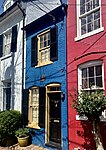Alexandria Library sit-in
The Alexandria Library sit-in was one of the first staged sit-in actions in the United States, pioneering the use of nonviolent direct action to demand equal rights for African Americans. On August 21, 1939, five Black men sat down inside the Alexandria Public Library and quietly read books, a transgression of the library's "whites only" policy. Their actions were coordinated by Alexandria attorney Samuel Wilbert Tucker, who planned the action to create a test case challenging the library's racial segregation policy. The men were escorted out of the library by police and charged with disorderly conduct. A ruling was not filed in their court case; in October 2019, all charges against the men were dismissed. The Alexandria sit-in is one of the earliest precursors in the U.S. of the strategies used during the civil rights movement.
Excerpt from the Wikipedia article Alexandria Library sit-in (License: CC BY-SA 3.0, Authors).Alexandria Library sit-in
Queen Street, Alexandria
Geographical coordinates (GPS) Address Nearby Places Show on map
Geographical coordinates (GPS)
| Latitude | Longitude |
|---|---|
| N 38.807777777778 ° | E -77.046944444444 ° |
Address
City of Alexadria Public Library
Queen Street
22314 Alexandria
Virginia, United States
Open on Google Maps









